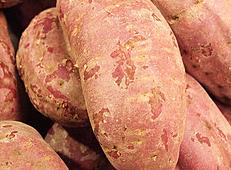Yams
| Infobox on Yams | |
|---|---|
| Example of Yams |  |
| Freshness facts | |
| Optimum carrying temperature | 16°C |
| Highest freezing point | -1,1°C |
| Acceptable product temp. at loading into containers | Max. 2°C above carrying temperature |
| Optimum humidity | 70% to 80% |
| Ventilation setting for containers | 10 m³/hr |
| Storage life | 2 to 6 months |
| Climacteric / non-climacteric | Non-climacteric |
| Ethylene production | Very low |
| Ethylene sensitivity | Low |
| Modified / controlled atmosphere | - |
| Potential benefits | - |
| Availability | |
| On demand | |
Yams
Contents
Harvesting and Handling
There are many types of yams, and considerable confusion exists both in common names and scientific names. In the USA sweetpotatoes are sometimes called yams.
It is difficult to harvest yams without causing injury. Consequently, if storage or shipment is intended, it is important to allow a period of curing immediately after harvest. Curing allows suberization of surface injuries and reduces weight loss and rotting in storage.
Yams for export should be carefully selected and packed in ventilated cartons or crates. Ventilated carriage is feasible.
Cooling and Storage
Storage at 16°C with 70% to 80% and adequate ventilation is recommended for storage of cured yams. Under these conditions, properly cured yams should keep 6 months.
Yams are chilling sensitive and will be injured at 12°C and below. Low-temperature injury has been observed after 5 weeks at 5°C or 7°C, 3 weeks at 3°C, and 5 days at 2°C. When chilled, tissues discolour, soften with a waterlogged consistency, and eventually decay.
Controlled atmosphere considerations
Little data available but there appears to be no reason to use CA.
Storage disorders
Botryodiplodia rot, Fusarium, Pyhtium rot, Sclerotium rot, Aspergillus rot, Bacterial soft rot, Black rot, Grey mould rot, Pink mould rot.











